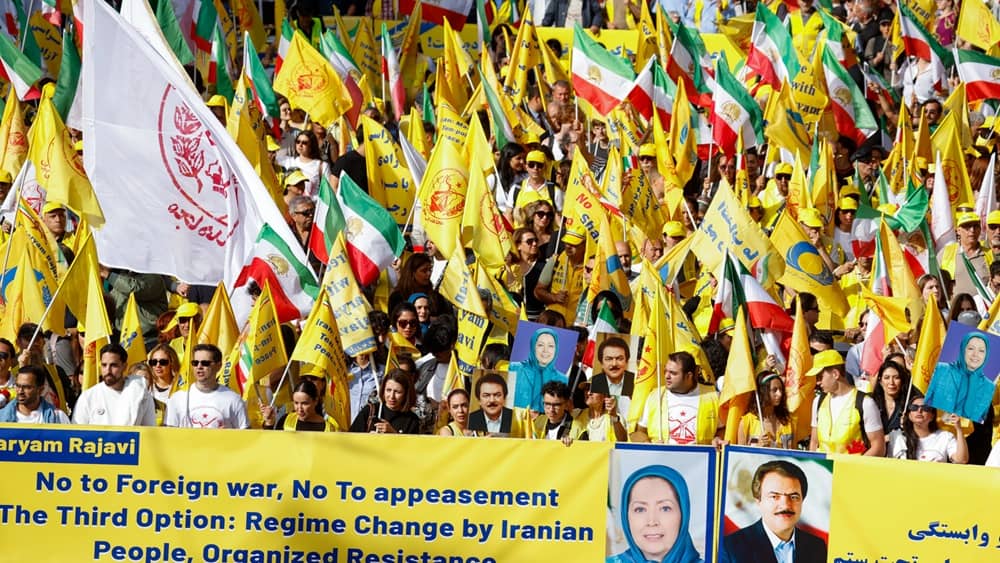
Three-minute read
The clerical regime’s officials and propaganda outlets have once again revealed their deepest fear: the role of the Iranian opposition, particularly the People’s Mojahedin Organization of Iran (PMOI/MEK), in exposing secrets, driving uprisings, and mobilizing support abroad. From the first disclosure of Tehran’s clandestine nuclear sites to the 2017 nationwide protests and this month’s rally in Brussels, the same thread runs through the regime’s narrative — that the PMOI is its most dangerous adversary.
Admissions on the 2017 uprising
On September 17, 2025, former communications minister Mohammad-Javad Azari Jahromi recalled how the protests that erupted in Mashhad in December 2017 quickly spiraled beyond control. He claimed that the initial demonstration had been organized by pro-regime groups, but that it was rapidly overtaken: “Another current came in and started shouting slogans against the structure. The PMOI rode on the issue and unrest broke out in the provinces.”
Jahromi acknowledged that state forces effectively abandoned the scene, allowing anti-regime slogans to spread nationwide. According to him, PMOI sympathizers “heated up the political atmosphere” and “created unrest across the provinces.” His account underscores what the regime has long tried to deny publicly: that the PMOI channeled widespread frustration into a coordinated nationwide challenge.
Oct 7- Mehdi Rahimabadi, Khamenei’s rep in Birjand: “Parents have a very serious responsibility to make sure their children don’t end up in the traps set by the infiltrators and the #MEK.”
9/10https://t.co/o8bkPV0mXk pic.twitter.com/gYK7s7hcul— NCRI-FAC (@iran_policy) October 9, 2022
Nuclear disclosures that changed everything
Another inadvertent admission came on September 10, from former Majlis deputy Ebrahim Karkhaneh. He reminded audiences that Tehran’s nuclear standoff with the world powers “began in August 2002,” when the PMOI held a press conference in Washington to reveal secret enrichment facilities in Natanz and Arak.
Karkhaneh called the revelation “the starting point of the conspiracy against the Islamic Republic” but confirmed its decisive impact. “After this, the IAEA secretary-general came to Iran,” he said, adding that between 2003 and 2006, “while we had suspended all nuclear activity, the IAEA board passed eight resolutions against us.”
The statement, though intended as denunciation, highlighted a reality: the PMOI’s disclosures permanently altered the regime’s nuclear trajectory, making international scrutiny unavoidable.
Propaganda and panic before Brussels
This September, the same pattern of fear resurfaced ahead of the NCRI’s annual rally in Brussels on the 15th. Two days before the gathering, an IRGC Quds Force outlet accused the PMOI of planning a staged “self-explosion” to frame the regime, echoing crude disinformation campaigns from the 1980s. The outlet called it a “childish trick” designed to gain sympathy and pressure the European Union.
Despite the regime’s scare tactics, the Brussels rally went ahead and drew large crowds from supporters of the Iranian Resistance who celebrated PMOI’s 60th anniversary. The conspiracy narrative about a staged “self-explosion” was less about credibility than about intimidation — an effort to frighten supporters of the movement and discourage turnout by raising the specter of a bombing. The tactic was particularly sinister given that in 2018, a senior Iranian diplomat was convicted in Belgium for masterminding a foiled bombing attempt against the NCRI’s Free Iran gathering in Villepinte, near Paris.
#Iran News: #IRGC Media Reveals Deep Regime Fear of PMOI’s Growing Power at Home and Abroadhttps://t.co/zSBENSyqmN
— NCRI-FAC (@iran_policy) May 31, 2025
A continuous thread of fear
From the revelations of 2002 to the protests of 2017 and the Brussels rally of 2025, the regime’s behavior reveals a consistent truth. Its officials openly admit the PMOI’s role in triggering crises, while state media wage desperate campaigns to discredit the group. The fixation itself is telling: at every turn of internal unrest and international confrontation, the clerical regime sees the PMOI as the central threat.
What state officials disclosed — and what its outlets tried to obscure — confirms that the PMOI is not merely a historical adversary. For a regime beset by economic collapse, international isolation, and growing unrest, the organization represents the force capable of transforming discontent into organized resistance.
The clerics may label it “sedition” or “conspiracy,” but their own actions betray a deeper reality: after four decades in power, they remain haunted by the same opposition they failed to crush.

